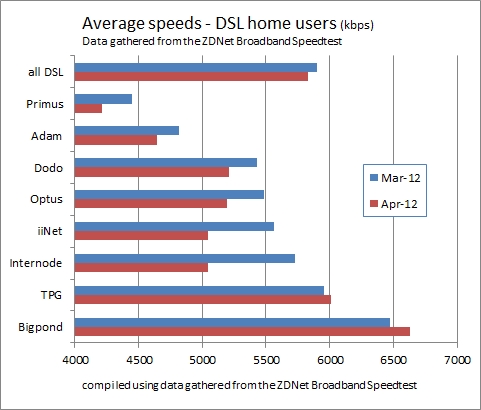Up to speed: that holiday traffic

The average speed experienced by home broadband users slowed over Easter, as more users jumped online. Does this mean ISPs are struggling to cope with peak demand?
Last year, with data gathered by the ZDNet Broadband Speedtest, we saw a gradual increase in internet speeds each month, as users moved up to higher-speed plans or switched technologies. Last month, a different picture emerged, with average speeds for home DSL users actually slowing. It was at its worst over the Easter weekend, with average DSL speeds 5 per cent slower than they were during the previous month.
This points to, we suspect, constrained contention ratios. In other words, ISPs just don't have the capacity to cope with so many of us online, at the same time. You can have the fastest speed possible, but if there isn't enough backhaul capacity, everyone ends up fighting for their share.
The graph shows how a speed drop was experienced by DSL customers of almost every major ISP. Telstra and TPG were the two exceptions. They also provided the fastest speeds, overall. iiNet and Internode had the biggest drop in average speeds — both falling around 10 per cent in April.
Some of these findings seem rather surprising, but we're confident that they are an accurate representation of what's happening. They come from an analysis of 161,486 Australian speed tests, which were conducted on the ZDNet Australia website in March and April 2012 — that's a pretty big sample size. The test, itself, involves downloading a file hosted by Akamai, so it's unlikely there's any advantage felt by one network over another.

(Credit: Phil Dobbie/ZDNet Australia)
We also saw a big fall in cable speeds. Telstra was the biggest culprit here, dropping by more than 10 per cent, from 18,075Kbps in March to 16,126Kbps in April. This is likely to be from congestion in the shared access infrastructure — our theory is that it's a consequence of more of us using connected TVs to download movies at peak time. Optus cable speeds also fell, but only by 2 per cent, to a speed of 16,686Kbps in April.
The drop in fibre speeds is based on our sample of more than 3000 speed tests by users on fibre connections — we saw average speeds drop a massive 33 per cent in April.
These are all signs of how a poorly proportioned network can impact the user experience. Let's hope that in a bandwidth-hungry post-NBN world, our access to high-speed broadband doesn't slow to a walking pace.
Updated at 3.20pm, 29 May, 2012: The figure in paragraph five was changed to reflect only Australian results (as opposed to total global test results).